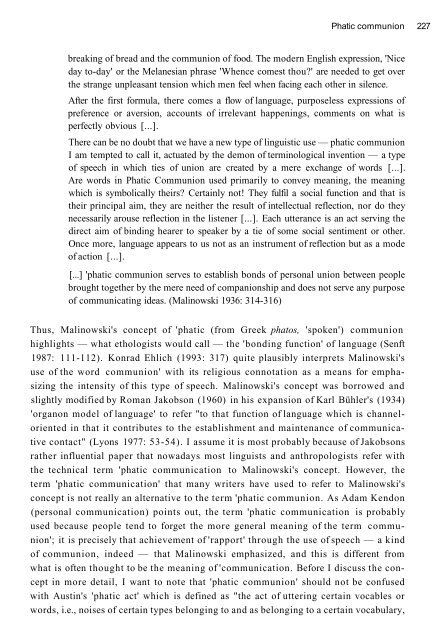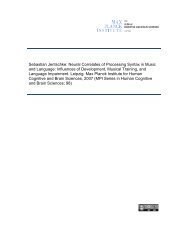Phatic communion - PubMan
Phatic communion - PubMan
Phatic communion - PubMan
Create successful ePaper yourself
Turn your PDF publications into a flip-book with our unique Google optimized e-Paper software.
<strong>Phatic</strong> <strong>communion</strong> 227<br />
breaking of bread and the <strong>communion</strong> of food. The modern English expression, 'Nice<br />
day to-day' or the Melanesian phrase 'Whence comest thou?' are needed to get over<br />
the strange unpleasant tension which men feel when facing each other in silence.<br />
After the first formula, there comes a flow of language, purposeless expressions of<br />
preference or aversion, accounts of irrelevant happenings, comments on what is<br />
perfectly obvious [...].<br />
There can be no doubt that we have a new type of linguistic use — phatic <strong>communion</strong><br />
I am tempted to call it, actuated by the demon of terminological invention — a type<br />
of speech in which ties of union are created by a mere exchange of words [...].<br />
Are words in <strong>Phatic</strong> Communion used primarily to convey meaning, the meaning<br />
which is symbolically theirs? Certainly not! They fulfil a social function and that is<br />
their principal aim, they are neither the result of intellectual reflection, nor do they<br />
necessarily arouse reflection in the listener [...]. Each utterance is an act serving the<br />
direct aim of binding hearer to speaker by a tie of some social sentiment or other.<br />
Once more, language appears to us not as an instrument of reflection but as a mode<br />
of action [...].<br />
[...] 'phatic <strong>communion</strong> serves to establish bonds of personal union between people<br />
brought together by the mere need of companionship and does not serve any purpose<br />
of communicating ideas. (Malinowski 1936: 314-316)<br />
Thus, Malinowski's concept of 'phatic (from Greek phatos, 'spoken') <strong>communion</strong><br />
highlights — what ethologists would call — the 'bonding function' of language (Senft<br />
1987: 111-112). Konrad Ehlich (1993: 317) quite plausibly interprets Malinowski's<br />
use of the word <strong>communion</strong>' with its religious connotation as a means for emphasizing<br />
the intensity of this type of speech. Malinowski's concept was borrowed and<br />
slightly modified by Roman Jakobson (1960) in his expansion of Karl Bühler's (1934)<br />
'organon model of language' to refer "to that function of language which is channeloriented<br />
in that it contributes to the establishment and maintenance of communicative<br />
contact" (Lyons 1977: 53-54). I assume it is most probably because of Jakobsons<br />
rather influential paper that nowadays most linguists and anthropologists refer with<br />
the technical term 'phatic communication to Malinowski's concept. However, the<br />
term 'phatic communication' that many writers have used to refer to Malinowski's<br />
concept is not really an alternative to the term 'phatic <strong>communion</strong>. As Adam Kendon<br />
(personal communication) points out, the term 'phatic communication is probably<br />
used because people tend to forget the more general meaning of the term <strong>communion</strong>';<br />
it is precisely that achievement of 'rapport' through the use of speech — a kind<br />
of <strong>communion</strong>, indeed — that Malinowski emphasized, and this is different from<br />
what is often thought to be the meaning of 'communication. Before I discuss the concept<br />
in more detail, I want to note that 'phatic <strong>communion</strong>' should not be confused<br />
with Austin's 'phatic act' which is defined as "the act of uttering certain vocables or<br />
words, i.e., noises of certain types belonging to and as belonging to a certain vocabulary,












